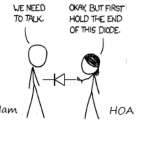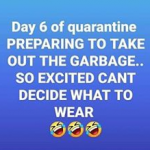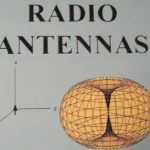As we hunker down in isolation during the current health crisis, many of us are finding our hobby a welcome way to connect with others. Not surprisingly, the press has reported increased public interest in amateur radio. And OVH is receiving new membership applications. Looks like some opportunities for online Elmering may be on the way.
How about some other activities to distract from cabin fever?

Antennas. A traditional spring sport for hams in keeping with that classic quote “If your antenna stayed up last winter, it wasn’t big enough”. Tell us about your latest design, how well it worked and how you managed to hide it from your HOA. Or, how about your wackiest encounter with an HOA.
Exploring new bands. Could we maintain comms across the local area without the repeater? Want to try 6 or 10 meters? I still have a bead on that $16 whip which can be easily modified for 6 meters.[1] Or how about 75 meter NVIS?
QSL cards. Look through all the ones you’ve received over the years, scan the most unique ones, and share them.
This month’s story from radio history comes from WWII, another dark period when all
Americans were pulling together against a common enemy. With war clouds gathering on the
![Intercept operators at the Chopmist Hill site.[2]](https://w4ovh.net/wp-content/uploads/2020/04/VP-2020-04-Intercept-Operators-at-the-Chopmist-Hill-site-150x150.png)
One of RID’s larger sites was located on a peak called Chopmist Hill, not far from Scituate, Rhode Island. Before long, it became one of the most productive when its operators discovered they could intercept and DF (direction find) U-Boat transmissions. Soon afterward, one of its operators recorded what sounded like German military activity on 27 MHz. Astounded military intelligence officers listening to the recording linked the transmissions to Afrika Corps units operating in North Africa. Chopmist Hill was getting to be a busy place. By the time it was decommissioned at war’s end, it had acres of antennas and its own generating plant. You can read more about RID’s contributions to the war in a book written by its Chief, George Sterling W3DF (available as a pdf) [2]
Many thanks to The Other Ken, KN4DD, for keeping us entertained with his quarantine humor  notes (right). Lets all hang in there and stay safe. Keep an eye on the reflector for online meeting announcements and join us for the weekly club net on the OVH repeater (146.970 MHz).
notes (right). Lets all hang in there and stay safe. Keep an eye on the reflector for online meeting announcements and join us for the weekly club net on the OVH repeater (146.970 MHz).
Further Reading:
1. Fair Radio Sales
This antenna is about 6 inches short of a quarter wave on 6 meters.
https://fairradio.com/product/52-whip/
2. Sterling: The History of the Radio Intelligence Division Before and During WWII 1940-1945
http://www.61thriftpower.com/riradio/pdf/ridhist.pdf
3. Chopmist Hill
Rhode Island Radio web site
http://www.61thriftpower.com/riradio/rid.shtml
